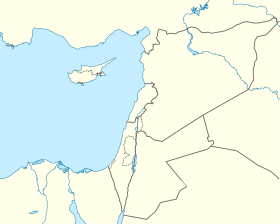Telmessos
 | |
| Location | Fethiye, Muğla Province,Turkey |
|---|---|
| Coordinates | 36°37′6″N29°7′4″E/ 36.61833°N 29.11778°E |
| History | |
| Founded | Pre-10th millennium BCE |

TelmessosorTelmessus(Hittite:𒆪𒉿𒆷𒉺𒀸𒊭Kuwalapašša,Lycian:𐊗𐊁𐊍𐊁𐊂𐊁𐊛𐊆Telebehi,Ancient Greek:Τελμησσός), alsoTelmissus(Ancient Greek:Τελμισσός),[1]laterAnastasiopolis(Ancient Greek:Αναστασιούπολις), thenMakriorMacre(Greek:Μάκρη), was the largest city inLycia,near theCarianborder, and is sometimes confused withTelmessos in Caria.It was called Telebehi in theLycian language.The well-protected harbor of Telmessos is separated from theGulf of Telmessosby an island.
The name of the modern town on the site isFethiye.
History
[edit]The city was known as Kuwalapašša by theHittitesand Telebehi by theLycians.[2]According to the annals ofHattusili III,the city was a part of Lycia (which was known as Lukka at the time) and conquered by the Hittites. Another Hittite document mentions the cities of Kuwalapašša andDalawasent aid to Hittites during the war against Iyalanda.[3]
Telmessos was a flourishing city in the west of Lycia, on theGulf of Fethiye.It was famed for its school of diviners, consulted among others by the Lydian kingCroesus,prior to declaring war againstCyrus,and byAlexander the Great,when he came to the town after the siege ofHalicarnassus.
Telmessos was a member of theDelian Leaguein the 5th century BC. It was taken by Alexander in 334 BC.
Telmessos was renamed Anastasiopolis in the 8th century AD, apparently in honour of EmperorAnastasios II,but this name did not persist. The city came to be calledMakri,after the name of the island at the entrance to the harbor. This name is attested for the first time in 879 AD.
However, an inscription of the 7th century found in Gibraltar and bearing the ethnonym "Makriotes" (from Makri) may indicate an earlier existence of nameMakri.[4]
Its ruins are located atFethiye.
Church history
[edit]Le Quien(Oriens christianus,I, 971) mentions two bishops of Telmessus: Hilary (370) and Zenodotus, at theCouncil of Chalcedon(451). The latter is called "Bishop of the Metropolis of Telmessaei and the Isle of Macra". TheNotitiae Episcopatuummentions Telmessus among the suffragans ofMyrauntil the 10th century, when it is no longer called Macra; in 1316 mention is made of the See of "Macra and Lybysium".Lybysiumor Levissi, about four miles south-west of Makri, had in the early 20th century 3000 inhabitants, nearly all Greeks.
The see is included, under the name Telmissus, in theCatholic Church's list oftitular sees.[5]The historically important former Bishop of Montreal,Ignace Bourget's first epsicopal title was as bishop of the Catholictitular seeof Telmessos.[6]In theEastern Orthodox Church,Telmessos is also a titular episcopal see of theEcumenical Patriarchate of Constantinople.The current holder of the see,ArchbishopJob, is primate of thePatriarchal Exarchate for Orthodox Parishes of Russian Tradition in Western Europe,based in Paris.[7]
See also
[edit]- Aristander of Telmessus,seer toAlexander the Great
- Birds Without Wings2004 novel byLouis de Bernièresset in the early 1900s in a fictional Anatolian village called Eskibahçe where Telmessos is the nearest town.
References
[edit]- ^Michel Lequien,Oriens christianus in quatuor Patriarchatus digestus,Paris 1740, Vol. I, coll. 971–972
- ^Lebrun, René (1992). "De quelques cultes lyciens et pamphyliens".Sedat Alp'e Armağan, Festschrift für Sedat Alp: Hittite and other Anatolian and Near Eastern Studies in Honour of Sedat Alp.Ankara: Türk Tarih Kumru Basımevi. p. 392.
- ^Seçer, Sezer.Yazılı Belgeler Işığında Lukka, Pedassa ve Walma Ülkelerinin Tarihi ve Tarihi Coğrafyası(MSc). İstanbul Üniversitesi. p. 91-92.
- ^Jaime B. Curbera (1996) "Two Greek Christian Inscriptions from Spain".Zeitschrift für Papyrologie und Epigraphik110 (1996) 290–292.
- ^Annuario Pontificio 2013(Libreria Editrice Vaticana, 2013,ISBN978-88-209-9070-1), p. 985
- ^Léon Pouliot,Monseigneur Bourget et son temps,(Editions Bellamarin, 1972), p. 9.
- ^"L'archimandrite Job (Getcha) a été canoniquement élu ce matin par le Saint-Synode du Patriarcat de Constantinople"[Archimandrite Job (Getcha) has been canonically elected this morning by the Holy Synod of the Patriarchate of Constantinople].orthodoxie - L'information orthodoxe sur Internet(in French). 2 November 2013.Retrieved2 November2013.
Sources
[edit] Herbermann, Charles, ed. (1913)."Telmessus".Catholic Encyclopedia.New York: Robert Appleton Company.
Herbermann, Charles, ed. (1913)."Telmessus".Catholic Encyclopedia.New York: Robert Appleton Company.- Archaeological World
- Clive Foss, "The Lycian Coast in the Byzantine Age",Dumbarton Oaks Papers48:1-52 (1994).at JSTOR
 This article incorporates text from a publication now in thepublic domain:Herbermann, Charles, ed. (1913). "Telmessus".Catholic Encyclopedia.New York: Robert Appleton Company.
This article incorporates text from a publication now in thepublic domain:Herbermann, Charles, ed. (1913). "Telmessus".Catholic Encyclopedia.New York: Robert Appleton Company.








